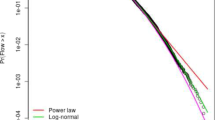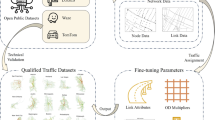Abstract
A data-driven realistic design and evaluation of vehicular mobility has been particularly challenging due to a lack of large-scale real-world measurements in the research community. Current research methodologies rely on artificial scenarios, random connectivity, and use small and biased samples. In this paper, we perform a combined study to learn the structure and connectivity of urban streets and modeling and characterization of vehicular traffic densities on them. Our dataset is a collection of more than 222 thousand routes and 25 million vehicular mobility images from 1091 online web cameras located in six different regions of the world. Our results centered around four major observations: i. Study shows that driving routes and visiting locations of regions demonstrate power-law distribution, indicating a planned or recently designed road infrastructure. ii. We represent regions by network graphs in which nodes are camera locations and edges are urban streets that connect the nodes. Such representation exhibits small world properties with short path lengths and large clustering coefficient. iii. Traffic densities show 80% temporal correlation during several hours of a day. iv. Modeling traffic densities against known theoretical distributions show less than 5% deviation for heavy-trailed models such as log-logistic and log-gamma distributions. We believe this work will provide a much-needed contribution to the research community for design and evaluation of future vehicular networks and smart cities.
Similar content being viewed by others
References
F. Bai and B. Krishnamachari, “Spatio-temporal variations of vehicle traffic in VANETs: Facts and implications,” in Proc. 6th ACM Int. Workshop VehiculAr InterNETworking (VANET). New York: ACM, 2009, pp. 43–52.
F. Bai, N. Sadagopan, and A. Helmy, “The IMPORTANT framework for analyzing the impact of mobility on performance of routing protocols for adhoc networks,” Ad Hoc Netw., vol. 1, no. 4, pp. 383–403, Nov. 2003.
M. Batty, “Network geography: Relations, interactions, scaling and spatial processes in GIS,” in Re-Presenting GIS, P. Fisher and D. Unwin, Eds. Chichester, UK: Wiley, 2003, pp. 149–169.
J. J. Blum, A. Eskandarian, and L. J. Hoffman, “Challenges of intervehicle ad hoc networks,” IEEE Trans. Intell. Transp. Syst., vol. 5, no. 4, pp. 347–351, Dec. 2004.
A. Cardillo, S. Scellato, V. Latora, and S. Porta, “Structural properties of planar graphs of urban street patterns,” Phys. Rev. E, vol. 73, no. 6, pp. 066107-1–066107-8, Jun. 2006.
R. E. Chandler, R. Herman, and E. W. Montroll, “Traffic dynamics: Studies in car following,” Oper. Res., vol. 6, no. 2, pp. 165–184, Mar.–Apr. 1958.
S. C. S. Cheung and C. Kamath, “Robust background subtraction with foreground validation for urban traffic video,” EURASIP J. Adv. Sig. Pr., vol. 2005, pp. 2330–2340, Jan. 2005.
P. Crucitti, V. Latora, and S. Porta, “Centrality measures in spatial networks of urban streets,” Phys. Rev. E, vol. 73, no. 3, pp. 036125-1–036125-5, Mar. 2006.
N. K. Dave and V. B. Vaghela, “Vehicular traffic control: A ubiquitous computing approach,” in Proc. 2nd Int. Conf. Contemporary Computing, Noida, India, 2009, pp. 336–348.
A. M. Elgammal, D. Harwood, and L. S. Davis, “Non-parametric model for background subtraction,” in Proc. 6th European Conf. Computer Vision (ECCV), Part II. London: Springer, 2000, pp. 751–767.
P. Erdős and A. Rényi, “On the evolution of random graphs,” Publ. Math. Inst. Hung. Acad. Sci., Ser. A 5, pp. 17–61, 1960.
G. E. Burnett and J. M. Porter, “Ubiquitous computing within cars: Designing controls for non-visual use,” Int J. Human-Comput. Stud., vol. 55, no. 4, pp. 521–531, Oct. 2001.
J. Jiru and D. Eilers, “Car to roadside communication using IEEE 802.11p technology,” Industrial Ethernet Book, vol. 2011, no. 64/29, May 2011.
S. Kaul, M. Gruteser, V. Rai, and J. Kenney, “On predicting and compressing vehicular GPS traces,” in Proc. IEEE Int. Conf. Communications Workshops (ICC), Cape Town, South Africa, 2010.
D. Kotz and T. Henderson, “CRAWDAD: A community resource for archiving wireless data at Dartmouth,” IEEE Pervas. Comput., vol. 4, no.4, pp. 12–14, Oct.–Dec. 2005.
J. Krumm, “Trajectory analysis for driving,” in Computing with Spatial Trajectories, Y. Zheng and X. Zhou, Eds. New York: Springer, 2011, pp. 213–241.
R. Lienhart and J. Maydt, “An extended set of Haar-like features for rapid object detection,” in Proc. Int. Conf. Image Processing (ICIP), 2002, vol. 1, pp. 900–903.
Q. Meng and H. L. Khoo, “Self-similar characteristics of vehicle arrival pattern on highways,” J. Transp. Eng., vol. 135, no. 11, pp. 864–872, Nov. 2009.
M. M. Moore and B. Lu. (2011, Jun.). Autonomous vehicles for personal transport: A technology assessment [Online]. Available: http://papers.ssrn.com/sol3/papers.cfm?abstract_id=1865047.
M. Piccardi, “Background subtraction techniques: A review,” in Proc. IEEE Int. Conf. Systems, Man and Cybernetics, The Hague, Netherlands, 2004, vol. 4, pp. 3099–3104.
M. Piórkowski, M. Raya, A. Lezama Lugo, P. Papadimitratos, M. Grossglauser, and J.-P. Hubaux “TraNS: Realistic joint traffic and network simulator for VANETs,” ACM SIGMOBILE MC2R, vol. 12, no. 1, pp. 31–33, Jan. 2008.
S. Porta, V. Latora, F. Wang, S. Rueda, E. Strano, S. Scellato, A. Cardillo, E. Belli, F. Crdenas, B. Cormenzana, and L. Latora, “Street centrality and location of economic activities in Barcelona,” Urban Stud., vol. 49, no. 7, pp. 1471–1488, May 2012.
S. Porta, V. Latora, F. Wang, E. Strano, A. Cardillo, S. Scellato, V. Iacoviello, and R. Messora, “Street centrality and densities of retail and services in Bologna, Italy,” Environment and Planning B: Planning and Design, vol. 36, no. 3, pp. 450–465, 2009.
R. Stanica, E. Chaput, and A. Beylot, “Simulation of vehicular ad-hoc networks: Challenges, review of tools and recommendations,” Comput. Netw., vol. 55, no. 14, pp. 3179–3188, Oct. 2011.
C. Stauffer and W. E. L. Grimson, “Adaptive background mixture models for real-time tracking,” in Proc. IEEE Computer Society Conf. Computer Vision and Pattern Recognition, Fort Collins, USA, 1999.
Z. Sun, G. N. Bebis, and R. H. Miller, “On-road vehicle detection: A review,” IEEE Trans. Pattern Anal. Mach. Intell., vol. 28, no. 5, pp. 694–711, May 2006.
G. S. Thakur. (2012). Generating urban street network using Google Maps API [Online]. Available: http://www.cise.ufl.edu/~gsthakur/globalsense.shtml.
G. S. Thakur, M. Ali, P. Hui, and A. Helmy, “Comparing background subtraction algorithms and method of car counting,” arXiv:1202. 0549v1 [cs.CV], 2012.
A. G. Wilson, Complex Spatial Systems: The Modeling Foundations of Urban and Regional Analysis. Harlow, UK: Prentice Hall, 2000.
N. Wisitpongphan, F. Bai, P. Mudalige, V. K. Sadekar, and O. Z. Tonguz, “Routing in sparse vehicular ad hoc wireless networks,” IEEE J. Sel. Areas Commun., vol. 25, no. 8, pp. 1538–1556, Oct. 2007.
J. Yeo, D. Kotz, and T. Henderson “CRAWDAD: A community resource for archiving wireless data at Dartmouth,” ACM SIGCOMM CCR, vol. 36, no. 2, pp. 21–22, Apr. 2006.
S. Yoshihiro, K. Minoru, and K. Yukio, “Driverless car traveling guide system,” U.S. Patent 4 855 656, Aug. 8, 1989.
S. Yousefi, M. S. Mousavi, and M. Fathy, “Vehicular ad hoc networks (VANETs): Challenges and perspectives,” in Proc. 6th Int. Conf. ITS Telecommunications, Chengdu, China, pp. 761–766.
D. Zhang, N. Li, Z. Zhou, C. Chen, L. Sun, and S. Li, “iBAT: Detecting anomalous taxi trajectories from GPS traces,” in Proc. 13th Int. Conf. Ubiquitous Computing (UbiComp). New York: ACM, 2011, pp. 99–108.
Author information
Authors and Affiliations
Corresponding author
Rights and permissions
About this article
Cite this article
Thakur, G.S., Hui, P. & Helmy, A. The structure and traffic flow anatomy of the planet-scale urban vehicular mobility. Netw.Sci. 3, 13–23 (2013). https://doi.org/10.1007/s13119-013-0015-5
Received:
Revised:
Accepted:
Published:
Issue Date:
DOI: https://doi.org/10.1007/s13119-013-0015-5




